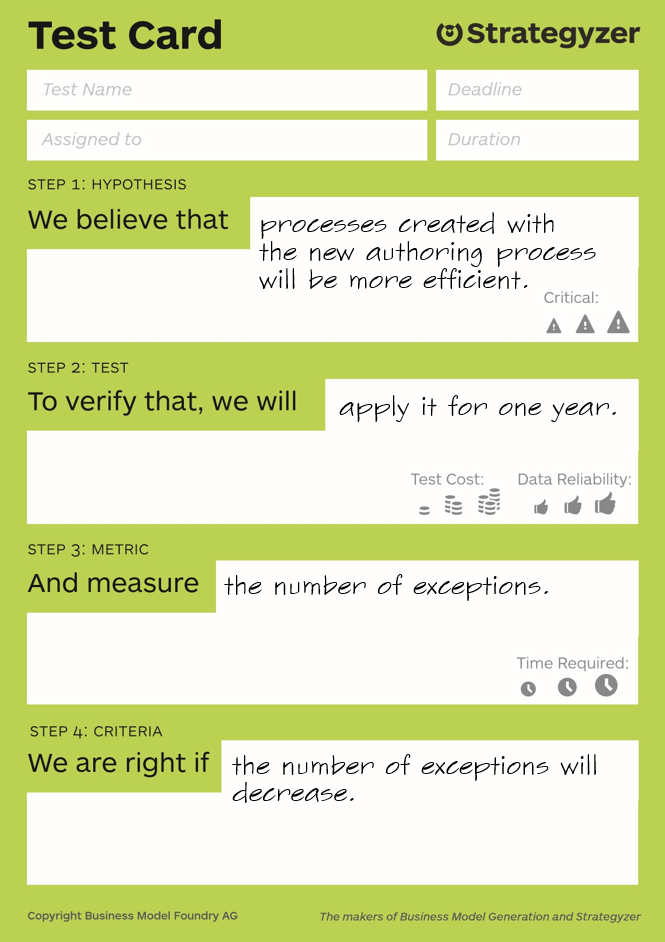Test Cards
Test cards help you to test and validate your business ideas by defining how you will test them, what you will measure, and what success looks like.
What Are Test Cards?
In a Lean Startup setting, it’s important for you to validate your business ideas before scaling them. Test cards are mentioned in the book Value Proposition Design, which is about learning how to create products and services that customers want.
Test cards contain four questions that help you to test a specific hypothesis. For example, your hypothesis could be that updating your brand’s logo to a more modern design will be more appealing to your customers and create a renewed sense of brand loyalty.
Test cards help you to stay focused on what to measure as you go about testing your hypothesis. It also helps you to define and quantify success to determine if your business idea is worth investing more time and money into.
 Source: Eloquens: The Testing Card
Source: Eloquens: The Testing Card
Why You Might Want Test Cards
- Validating your business ideas helps you to learn more about a belief you have that you can’t guarantee is true.
- Test cards help you to gather more information through testing and experimenting before sinking in too much money and resources in a business idea that might not be profitable.
- Using test cards is a practical process that can save you the frustration of making business decisions based on guesses or following what others are doing without looking at the specific needs of your own customers.
Problems Test Cards Help to Solve
How to Implement Test Cards
Test cards are especially valuable during the development and testing phases as you plan out the testing of your business ideas.
The first step before you start testing is to "search" for the right business model as you design and iterate to see if your idea could be successful. You would also need to test your value proposition in terms of the needs of your customers, your product value, and your customers' willingness or ability to pay for your product.
Test cards help you and your internal team to design and record better experiments as you continuously validate your business ideas with customer tests.
Test cards generally contain the following four questions:
- What is the idea (hypothesis) you would like to test?
- How will you verify if that hypothesis is true or false?
- What will you measure to test your hypothesis?
- What results will show that your hypothesis is true?
Common Pitfalls of Test Cards
- Forming the wrong hypothesis to test your business idea. This can happen when you overlook the root cause of a problem, or lean too heavily towards business perspective problems instead of customer perspective problems.
- Confirmation bias (only selecting evidence that agrees with your hypothesis).
- Analysis paralysis (overthinking too many details).
- Weak or messy data.
- Failure to learn from insights can also block progress in your testing process.
Resources for Test Cards
Want to write for DXKB?
Feel free to contribute. People from DXKB community will be more than happy.
Related articles
ALL ARTICLES
Design Thinking
Design thinking puts a user at the center of the product design. It means that users' needs and wants are prioritized first by taking an ergonomic and iterative approach during designing.
Read moreClickable Prototype
Clickable Prototypes are interactive demos of a website or a software application. These are often used to gather feedback early in the project lifecycle, before the project goes into the final stage of development.
Read moreLean Canvas
A Lean Canvas is a 1-page chart with 9 basic building blocks. It helps to identify problems and solutions for your product.
Read moreDesign Sprint
A Design Sprint is a framework that reduces the risks associated with product development. It is an intense process done by a small team in just 3 - 5 days.
Read moreFail Fast
Fail Fast is a method used during a recurrent approach to determine whether an idea has a value for the client or solution. An important goal is to minimize losses when testing reveals something is not working and quickly try something else.
Read moreALL ARTICLES